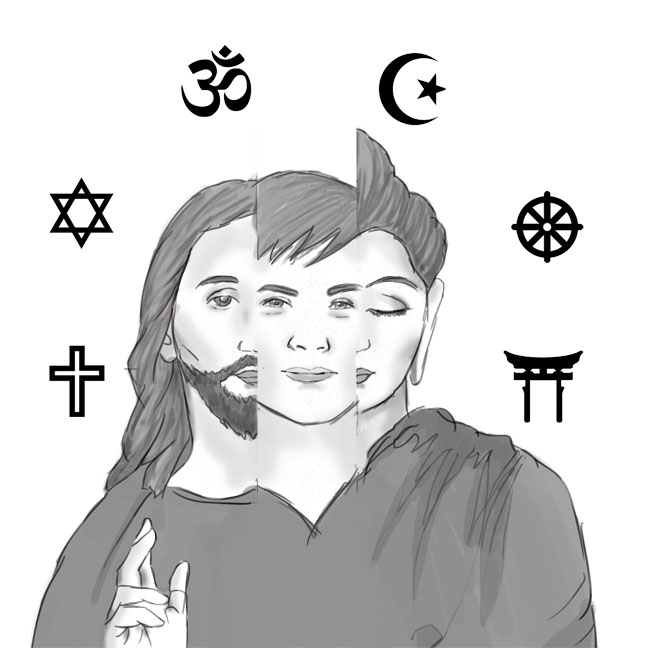What do we believe?
Students speak out about God, religion, prayer, faith, heaven and hell.
December 19, 2014

Student beliefs at Terrace
From the devout to the questioning, Terrace’s religious views are varied
Beliefs of Terrace
Each morning when senior Toqa Abosabaa gets dressed for the day, she secures a wide scarf, called a hijab, around her face with two pins, concealing her hair and neck from the rest of the world. This religious practice has become a central part of her everyday life.
“When I wear [a hijab] before I leave the house I feel like I’m dressed for a more important reason – like I’m dressed for God and not for people to see me,” Abosabaa said.
To Abosabaa and 57 percent of MTHS students, religion is at least a somewhat significant aspect of daily life. To the other 43 percent, religion is either not very important or simply unimportant.
Based on a scientific survey conducted by the Hawkeye, the largest religious majority at MTHS is Christian Protestant at 36 percent. The next most popular belief is actually the lack of one, as 26 percent of the student population reported to have no religion or religious beliefs.
Junior Mark Nguyen, who identifies as agnostic, attributed this non-religious segment to an increasingly scientific and secular-based society, as well as a lack of concern for religious topics and practices.
Nguyen, like many others, was raised in a Christian family, but said he never really connected with the church’s beliefs and was influenced by a number of different things to take on a mind-set that was more inquisitive and uncommitted to any one religion.
“I never really appealed to the whole ‘god’ idea. I guess it’s my personal beliefs and outside influences, like science, atheism, Buddhism. When I look at the world it’s super complex and [Christianity believes] it’s like this huge concept planned from the beginning by this superbeing. But that’s only one out of thousands of theories,” Nguyen said, explaining how he came to be agnostic.
A majority of students who are nonreligious have strayed from their family’s traditional beliefs, as Nguyen did. Of those who selected “no religion” as their religious preference, 67 percent said that they had differing religious views from their parents.
I would say it’s getting harder to be more focused on church because this year is really busy for me. I feel like last year and the year before it was easier to go to youth group and be focused on that but now I’m more stressed.
— Kaitlyn Anderson
This is the case for junior Jessica Phung, whose mother is Buddhist. Though Phung identifies as Buddhist, she said that she doesn’t associate with any religion at her core.
“[My mother] isn’t very religious either, but she believes in Buddha. When I ask about the point to religion she always tells me ‘It’s good to have something to believe in,’” Phung said.
It is also true for junior Erik Hogg, whose family tradition is Catholicism. He decided he didn’t believe in the teachings of Catholicism and chose instead to be an atheist.
Hogg believes that religion is a matter of personal opinion, and someone may decide to change that opinion if they find something that convinces them their religion may be false.
“I felt like it was the most reasonable thing to do. I didn’t believe in a lot of the [teachings]. It was kind of ridiculous to me. I had a hard time believing in people sitting on clouds looking down on me, and that people walked on water and split oceans,” Hogg said.
While around 75 percent of students affiliate with or believe in some type of religion, just 63 percent believe in a god. Another 24 percent are unsure about a god’s existence, and the rest are firm in their belief that there is no supreme deity.
These results are similar to Pew Research Center’s study, which examined the beliefs of adults throughout the nation and the state of Washington. The primary difference between students at MTHS and adults in Washington is that a higher percentage of students do not believe in a god or higher being.
Even fewer students believe in heaven and hell than in a god. Some 60 percent believe in heaven and 56 percent believe in hell.
“I think the idea of an afterlife sounds nice, but I would be okay without one. Who is to say that good people go to heaven? Who knows, maybe good people might end up in hell. Everyone living can’t give you the truth and the dead are gone,” Phung said. “The concept of heaven and hell is like the concept of naughty and nice. If you’re good, you’ll go to heaven and get all you wished for for Christmas. If not you’ll go to hell and get coal.”
While 62 percent of students said that their beliefs now are the same as when they began high school, another 24 percent said that they are less religious than when they began high school and the rest say they are more so.
For some, such as non-denominational Christian junior Kaitlyn Anderson, their faith and beliefs are essentially the same as when they began high school, but busy schedules and secular life can get in the way of religious practices.
“I would say it’s getting harder to be more focused on church because this year is really busy for me. I feel like last year and the year before it was easier to go to youth group and be focused on that but now I’m more stressed,” Anderson said.
Abosabaa is one of the 14 percent of students who believes she is more religious than when she started high school. She said that adversity she faced early on ended up driving her closer to her faith.
“Hardships aren’t a bad thing, they remind you what you’re really here for,” Abosabaa said.
Beliefs that students have about religious subjects vary, as do views on the importance of having a religion.
Though religion is not important in Phung’s own life, she understands why it would be important in the lives of others.
“Religion is something that gives hope. Many religious revivals were in times of hardship and if that’s what a person needs to keep living, who am I to criticize? If religion wasn’t important to others it would’ve died out a long time ago,” Phung said.
Nguyen also sees religion as something that is nonessential in his life. He said he doesn’t want to narrow his reliance down to one religion when there are so many uncertainties regarding the subject, but he sees why people do and why faith can become so dominant in one’s life.
“I think hope is one of the big factors because if you believe in a supreme and benevolent god, then it gives you hope that there is someone looking out for you. I guess that hope is there and maybe an answer to the world,” Nguyen said.
This idea of having an answer to the world and its purpose is a common theme with those who have faith.
Abosabaa’s personal experiences with religion attaching meaning to her actions exemplify this to a great extent.
“My religion is actually the reason why I decided to continue trying in school when I was having doubts about what it would give me,” Abosabaa said.
She had been falling behind and “wanted a greater purpose” than just getting a job and having a certain social status. Religion gave her that.
“One of the things Islam clearly points out to us is that we should understand why getting an education is important. It’s not education for the sake of an education, it has to be linked with values and goals. In getting an education you learn more about your life and the universe, and that helps us gain an understanding as to why we’re here,” Abosabaa said.
Gaining deeper faith in her religion also aided Abosabaa to come to terms with wearing her hijab, which she has done since she was an 8-year-old, filled with excitement about being more mature, like her mom.
As she aged, Abosabaa said she wanted to blend in with everyone else and felt like the hijab was a barrier between her and everyone else.
When she came to understand the purpose of wearing a hijab, she became more assured in wearing it and in herself. Her hijab ceased to be a barrier – it became her liberator.
“A lot of people who look at hijabis think that we dress that way because of men, but the real reason we wear it is to put our faith on display. We’re saying ‘I’m not here for display, my body is not for public consumption.’ When I cover my beauty, all you see is my faith and my soul.”


Eli Schenk • Feb 6, 2015 at 12:38 pm
Great article! I’m wondering about the font you used for the body– it looks great. Can you tell me what it is called?